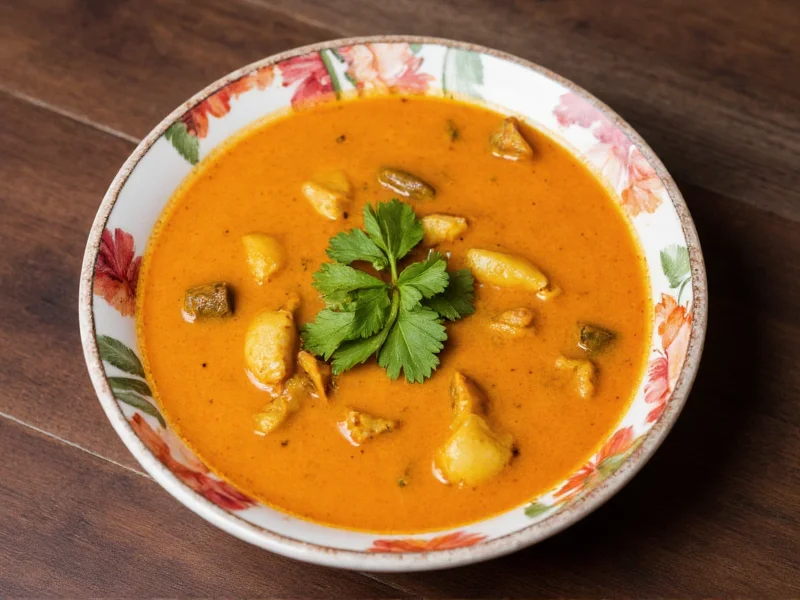Authentic Indian soups form an integral part of the subcontinent's culinary landscape, offering more than just nourishment—they reflect centuries of cultural exchange, regional diversity, and sophisticated flavor balancing. Unlike Western soup traditions that often emphasize creaminess or meat-based broths, traditional Indian soups prioritize complex spice profiles, digestive properties, and harmony with accompanying dishes. The most common types include rasam (a thin, peppery broth from South India), sambar (lentil-based vegetable stew), and shorba (a lighter broth influenced by Mughlai cuisine).
What distinguishes genuine Indian soup preparation is the careful layering of spices through techniques like tadka (tempering), where whole spices are fried in oil to release essential oils before incorporating them into the broth. This process creates depth that powdered spices alone cannot achieve. Traditional Indian vegetable soup preparations often begin with a base of onions, ginger, garlic, and tomatoes sautéed with cumin, mustard seeds, or curry leaves.
| Region | Signature Soup | Key Ingredients | Cultural Context |
|---|---|---|---|
| South India | Rasam | Tamarind, cumin, black pepper, tomatoes | Served with rice as digestive aid |
| North India | Shorba | Yogurt, mint, cardamom, bone broth | Mughlai influence, often Ramadan staple |
| East India | Mishti Shorba | Sweetened with jaggery, pumpkin, poppy seeds | Festive occasions, Durga Puja tradition |
| West India | Ghugni | Chickpeas, potatoes, mustard oil, pomegranate seeds | Street food culture, monsoon specialty |
The Cultural Significance of Indian Soups
Indian soup traditions extend far beyond mere sustenance—they embody Ayurvedic principles where specific combinations promote digestive health and balance bodily humors. Traditional Indian lentil soup like sambar isn't merely food; it's considered mitra ashni (a friend to digestion) in South Indian households. Many regional indian soup varieties incorporate ingredients specifically chosen for their seasonal appropriateness, such as cooling cucumber-based soups during summer or warming ginger-infused broths in winter.
Essential Ingredients in Authentic Preparations
Creating genuine indian soup recipes requires understanding the foundational elements that distinguish them from Western adaptations. The holy trinity of Indian soup bases typically includes:
- Tempered spices - Mustard seeds, cumin, fenugreek, or curry leaves fried in oil
- Acid components - Tamarind, tomatoes, kokum, or lemon providing necessary brightness
- Lentils or legumes - Toor dal, moong dal, or chickpeas adding body and protein
Unlike Western soup traditions that often rely on roux or cream for thickness, authentic indian vegetable soup achieves its texture through the natural breakdown of lentils and vegetables during slow simmering. The careful addition of finishing spices like garam masala or fresh cilantro just before serving preserves volatile aromatic compounds that would dissipate with prolonged cooking.
Avoiding Common Preparation Mistakes
Many homemade indian soup attempts fail by misunderstanding fundamental techniques. The most frequent errors include:
- Adding all spices at once rather than layering through tempering and finishing
- Overcooking delicate ingredients like tomatoes which turns them bitter
- Using pre-ground spices instead of whole spices tempered in oil
- Incorrect acid balance—too little makes soup flat, too much overwhelms other flavors
For those seeking authentic indian soup recipes, remember that regional variations matter significantly. A proper rasam from Tamil Nadu differs substantially from a Bengali dal shorba, despite both being lentil-based. Understanding these distinctions represents the difference between generic 'Indian-style' soup and genuinely regional indian soup varieties.
Modern Interpretations While Preserving Authenticity
Contemporary chefs are successfully bridging traditional techniques with modern palates through thoughtful adaptations. Some successful approaches include:
- Maintaining traditional spice combinations while adjusting heat levels for broader appeal
- Using traditional preparation methods with seasonal, locally-sourced vegetables
- Preserving the fundamental structure of regional indian soup varieties while presenting them in updated formats
The key to successful homemade indian soup lies in respecting the foundational principles of Indian culinary tradition while allowing for personal expression within those boundaries. Whether preparing a simple tomato rasam or an elaborate Mughlai shorba, understanding the 'why' behind each ingredient and technique leads to more authentic results than merely following steps in a recipe.
What's the difference between rasam and sambar?
Rasam is a thinner, more peppery broth made primarily with tamarind, tomatoes, and spices like cumin and black pepper, while sambar is a thicker lentil-based vegetable stew with a more complex spice profile including sambar powder. Rasam serves as a digestive aid typically consumed with rice, whereas sambar functions as a main accompaniment to rice dishes.
Can I make authentic Indian soup without traditional spices?
While substitutions can work, authentic flavor requires key spices like mustard seeds, cumin, and curry leaves for tempering. These cannot be fully replicated with ground alternatives. However, you can start with basic ingredients like ginger, garlic, and tomatoes to create a foundation, then gradually incorporate traditional spices as you build your pantry.
How do Indian soups differ from Western soups in preparation?
Indian soups emphasize spice layering through tempering (tadka) rather than roux or cream bases. They typically use whole spices fried in oil first, incorporate natural thickeners like lentils instead of flour, and balance flavors with acidic components like tamarind. The cooking process focuses on developing complex flavor profiles through sequential addition of ingredients rather than simmering everything together.
Are Indian soups typically served as starters or with meals?
In traditional Indian dining, soups aren't served as separate courses like in Western cuisine. Rasam and sambar are integral components of a full meal, served alongside rice, breads, and other dishes. Some lighter broths like shorba may be consumed independently during Ramadan or as digestive aids, but most Indian soups function as accompaniments rather than standalone starters.
What's the best way to store and reheat Indian soup?
Authentic Indian soups store well for 3-4 days in airtight containers. When reheating, add a small amount of water as lentils continue absorbing liquid. Crucially, restore the tempering by heating a teaspoon of oil with mustard seeds and curry leaves, then pouring this over the reheated soup to revive the authentic flavor profile that diminishes during storage.











 浙公网安备
33010002000092号
浙公网安备
33010002000092号 浙B2-20120091-4
浙B2-20120091-4